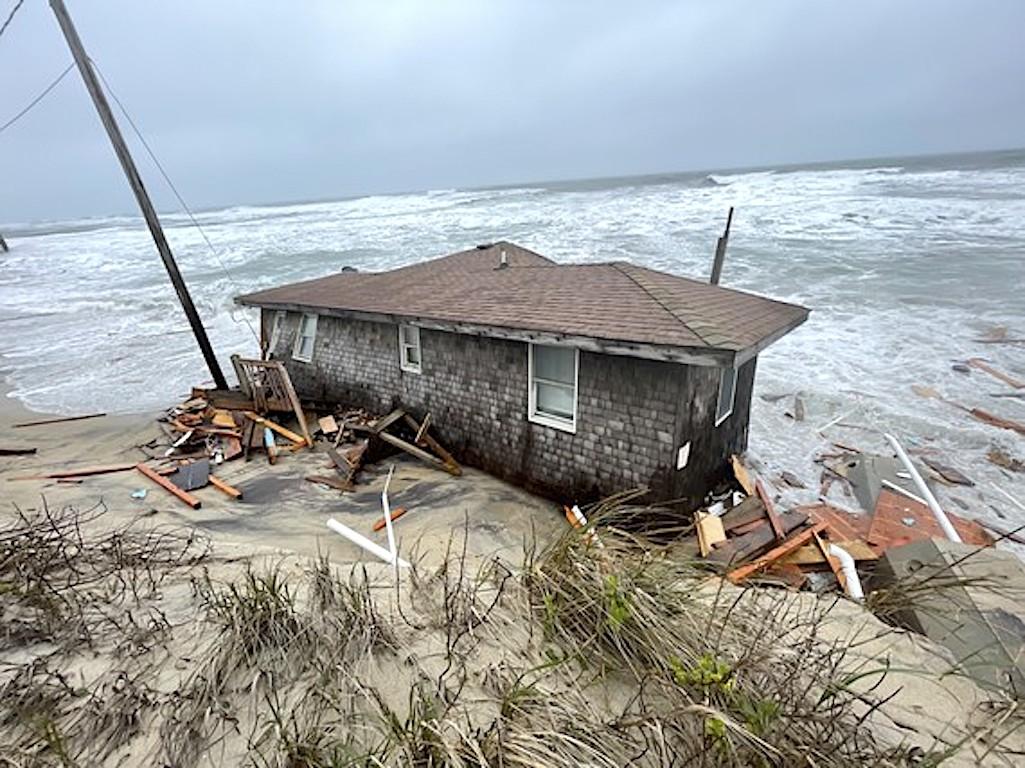
A report suggests that it would be less expensive to buy out the owners of houses at risk of being claimed by the Atlantic Ocean at Cape Hatteras National Seashore than paying to dump tons of sand on the beach/NPS file
As coastal erosion, sea-level rise, and more potent storms continue to risk the loss of beach houses at Cape Hatteras National Seashore in North Carolina, a new report suggests it would be much less costly to buy out the homeowners rather than investing in beach nourishment work.
The report, by Rob Young, director of the Program for the Study of Developed Shorelines at Western Carolina University, places the cost of buying 80 houses — one dating to 1965 — at risk of being pulled into the Atlantic at Rodanthe at nearly $43 million. The cost of dredging up tons of sand to place on the beachfront at Rodanthe to protect the houses is estimated at about $120 million over 15 years, according to Rodanthe Sand Needs Assessment Dare County, North Carolina, which was prepared by Coastal Science and Engineering.
"Even with beach nourishment, there will be periods of time between sand placement episodes when the beach will narrow, and the most exposed homes will be in the waves," Young writes in his report (attached below). "On the other hand, doing nothing has resulted in numerous high-profile incidents of homes collapsing into the sea, while septic tanks are exhumed and broken open. These events cause both environmental harm and a risk to public safety and health (the intertidal beach in this area is a part of Cape Hatteras National Seashore). Clearly, doing nothing is the worst option."
Young even considered lost tax revenue if a buyout was made, saying it would cost the county $7 millon-$10 million over 30 years.
"An advantage of buyouts is that the process could be piecemealed. A buyout plan could happen gradually, targeting the highest exposure properties and willing sellers first (likely the most practical approach)," he wrote. "The initial costs would be significantly smaller than beach nourishment, which will require substantial expenditure up front. In addition, buyouts could be initiated immediately, whereas beach nourishment will require substantial planning and permitting. A more gradual buyout process may cost less than the estimated $43 million, as the market value of properties will likely decrease as erosion begins to threaten homes. While this study does not prioritize the order of acquisition, further analysis could certainly provide the data to do so."
At least four homes have been claimed by the Atlantic at Rodanthe, and more are at risk of collapsing.
Dave Hallac, superintendent of the national seashore, says Young’s report helps the ongoing discussion of how to address the problem.
"I think that it adds to the discussion, particularly here at Cape Hatteras National Seashore," Hallac told the Traveler during its weekly podcast. "There are no easy solutions when it comes to the problem that we have. So, you know, when you're in a difficult situation like this, that is likely to get worse by the way, just as erosion continues and as the Earth changes, you’ve got to think long term, and you might as well put all the options on the table. So his work is certainly generating a lot of discussion."
As the national seashore's boundaries run up to the high tide line along the beachfront, any beach nourishment project would need to garner National Park Service approval.
"We start right at the border of a village called Nags Head, and when I say 'we,' I mean all Americans, of course, own the beach," Hallac said. "From there all the way to tip of Ocracoke Island, which is 75 miles. ... the eastern side of Rodanthe is part of Cape Hatteras Seashore. So if you want to put the sand on the beach, there, you're putting it in Cape Hatteras Seashore."
Back in 2021 the Park Service wrote a "sediment management plan" to govern any beach nourishment request. "It's actually a very detailed plan, describes monitoring requirements, grain size requirements, seasonality, frequency of applications, all that kind of stuff," the superintendent said.
The plan is in effect for 20 years and includes about 13 miles of beach to serve as a control of sorts against which to measure the impacts of dredging or pumping up sand and dumping it onshore.
"It's a great plan, and the reason that it is, is this is an opportunity, without a permit on my desk, to kind of sit back and say, we know these projects have some beneficial impacts. We also know they have some negative impacts," Hallac said at the time. "If we were able to design a series of conditions, mitigations, to ensure that these projects in the future really minimize all the negative things and really maximize the beneficial impacts, what would the framework look like? And that's what we did."

 Support Essential Coverage of Essential Places
Support Essential Coverage of Essential Places




Add comment